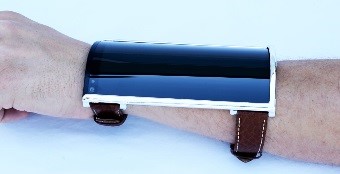Smartphone – The goal of the team at Arubixs (San Francisco, CA) is to “create a device that combines advanced smartphone technology with the convenience and mobility of smart watches and fitness trackers”. The device that the company proposes to develop is called Portal. This Android based smartphone is envisioned to be flexible, water resistant, shatterproof and wearable.
Two models of the Portal are under development, one at 4″ and one at 6″. Both models will include a flexible OLED display. As shown in the video appended below this article, the Portal is “ambidextrous” (that is, it can be mounted on either arm of the user) and sufficiently flexible to wrap around a user’s forearm. In this configuration, the device offers the advantage of not tying up either the user’s hands or pockets.

Features of the Portal include the following:
- Soft impact restive Kevlar infused body – helps make the Portal durable and flexible.
- Two side mounted cameras record the view to either side. There are also two front facing cameras. The four cameras support the fact that the Portal is ambidextrous.
- Stereo audio.
- 2 GB RAM and 64 GB internal storage.
- The user interface is also ambidextrous.
- Gesture and motion based native function commands (volume, unlock, home, back, etc.)
- Built in accelerometer, gyro, compass, proximity detector, barometer, Bluetooth 4.0, NFC, GPS and AGPS.
- Wireless charging capability.
- Supports Wi-Fi 802.11 b/g/n/ac.
Only vague details of the Portal’s configuration have been made available. This includes that the majority of the components that make up Portal derive from companies with familiar names. Nonetheless, we are told that the processor to be used in the Portal is not yet commercially available. Engineering samples have, however, been made available to Arubixs. The processor is expected to be commercially available by the time the Portal is ready to be produced. The same situation is represented as applying to the display and several other components that make up the Portal. Although this situation is not unique to Arubixs, there is clearly at least some risk associated with a production schedule and initial business plan based on the availability of components under development at other companies.
Portal runs the latest Android software with a custom user interface to support Portal’s additional features. Portal will support Android Apps and most apps from the Google Play Store.
The company has partnered with an unnamed but “well known” battery manufacturer to assist in developing a custom flexible battery for the Portal. Although the battery properties are still being tested, it is expected the capacity will be 3200 mhA enabling 8 hours of talk time.
The Portal will work on any carrier that supports the wireless over-the-air interface protocols listed in the specifications. Portal is a quad-band GSM based device with HSPA, LTE, and TD-LTE. The ability for Portal to operate on a specific carrier is based on the carrier’s frequencies.
The Portal currently includes an embedded SIM card. This basically means that the chip is soldered to a circuit board, an approach commonly used in devices intended for rugged applications. The reason for Portal adopting this approach is that embedding the SIM card removes the need for a SIM door. In conjunction with the fact that the device is button-less, this makes it easier to design the device to resist water penetration to the desired depth of 10 meters. On the down side, users will have to call their carrier to switch a SIM ID.
The company plans testing Portal to MIL-810G standards. In addition, the company plans to do Highly Accelerated Life Testing (HALT) on the final pre-production prototype.
One further hurdle that Arubixs will have to clear before the product can be sold is to achieve several wireless certifications. These include FCC, PTCRB, Bluetooth AG, WiFi Alliance, etc. In addition, it is also necessary that the Portal obtain wireless carrier device certifications for several wireless carriers around the globe. Consistent with this last requirement, the Portal is unlocked.
At this time, the company has built a team, designed PCBs and mechanical tooling, built prototypes, developed software and set up supplier logistics. The team believes that it is possible to move from this current status to production in 12 months. To make this happen, the company is currently looking for funding with a campaign listed on crowd funding site Indiegogo. The campaign will close on October 24. If the campaign does not reach its goal, the team states that they will pursue other means of financing. – Arthur Berman

